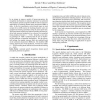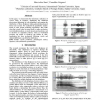INTERSPEECH
2010
13 years 6 months ago
2010
Basic language-inherent tempo cannot be isolated by the current metrics of speech rhythm. Here we propose the number of syllables per intonation unit as an appropriate measure, al...
INTERSPEECH
2010
13 years 6 months ago
2010
The Lombard effect refers to the speech changes due to the immersion of the speaker in a noisy environment. Among these changes, studies have already reported acoustic modificatio...
INTERSPEECH
2010
13 years 6 months ago
2010
This paper presents an improved wavelet-based dereverberation method for automatic speech recognition (ASR). Dereverberation is based on filtering reverberant wavelet coefficients...
INTERSPEECH
2010
13 years 6 months ago
2010
Log-linear models have recently been used in acoustic modeling for speech recognition systems. This has been motivated by competitive results compared to systems based on Gaussian...
INTERSPEECH
2010
13 years 6 months ago
2010
Dynamic modeling of spoken dialogue seeks to capture how interlocutors change their speech over the course of a conversation. Much work has focused on how speakers adapt or entrai...
INTERSPEECH
2010
13 years 6 months ago
2010
In an attempt to improve models of human perception, the recognition of phonemes in nonsense utterances was predicted with automatic speech recognition (ASR) in order to analyze i...
INTERSPEECH
2010
13 years 6 months ago
2010
Speech can be divided into discourse genres based on the contextual environment it occurs in (e.g. political speech, sport commentary speech, etc.). The present study investigated...
INTERSPEECH
2010
13 years 6 months ago
2010
Neural network language models (NNLM) have become an increasingly popular choice for large vocabulary continuous speech recognition (LVCSR) tasks, due to their inherent generalisa...
INTERSPEECH
2010
13 years 6 months ago
2010
We present a system for quickly and cheaply building transcribed speech corpora containing utterances from many speakers in a variety of acoustic conditions. The system consists o...
INTERSPEECH
2010
13 years 6 months ago
2010
In this paper, we demonstrate the trichotomic realization of voiced velars in Japanese, challenging the traditional plosive/nasal dichotomy of velar allophones, and examine the di...


